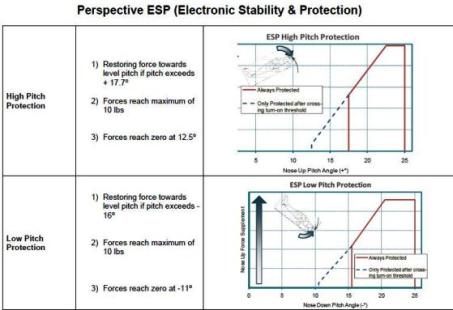Cirrus is now delivering its Garmin flight deck-equipped aircraft with an automatic descent mode to prevent hypoxia accidents and an electronic stability augmentation system meant to help prevent loss-of-control accidents when pilots are hand-flying the sidestick controlled aircraft.
The systems represent new passive backup capabilities that Cirrus says "completes the safety picture" for its four-seat single-engine line. Active safety systems (that the pilot has to physically select) include a whole airframe parachute system and a blue "level" button on the panel which will automatically return the wings and nose to level flight attitude using the autopilot.
Cirrus spent more than two years developing the electronic stability and protection system (ESP) with Garmin, a certification largely made in parallel with Garmin's program to certify ESP for the G1000 integrated avionics system on the King Air 200.
Announced in July, the ESP system for the SR20 and SR22 provides roll, pitch and overspeed protection when not in autopilot mode, provided the aircraft is more than 200ft (61m) above the ground. Rather than true envelope protection, ESP provides a restoring control stick force to alert the pilot of an impending unusual attitude, but the force can be overridden if the pilot so chooses.
 |
|---|
©CIRRUS AIRCRAFT |
Bank angles of 45 degrees or more are met with 2.3kg (5lb) of restoring stick force. If the pilot begins to recover, stick forces drop off to 0kg at 30 degrees bank. If the pilot continues past 45 degrees however, the restoring stick force increases to 3.2kg. Restoring forces for pitch operate in the same way, with 4.5kg applied when the pitch increases to 17.7 degrees nose up or 16 degrees nose down.
 |
|---|
©CIRRUS AIRCRAFT |
The hypoxia recognition and automatic descent mode, resident in the Perspective avionics system, monitors pilot inaction via a variety of "button pushes" into the Perspective avionics system, and will command the Garmin GFC 700 autopilot for a 1,000fpm descent if certain thresholds are not met.
Thresholds include 30min of non-activity at 15,000ft, a time limit that decreases to 5min at 25,000ft, the maximum certificated altitude for the non-pressurized aircraft. Once the first threshold is passed, the system displays an advisory message on the primary flight display. If no pilot activity takes place in the next 60s, a yellow caution message is displayed, accompanied by an audio announcement. If another 60s passes with no activity, the a red warning message is displayed along with an audio message. If no activity takes place in the next 120s, the autopilot will begin a descent to 14,000ft. Once at 14,000ft, if no activity occurs with 4min the GFC 700 will automatically descend to 12,500ft.
Aircraft owners who purchased their aircraft starting in September will automatically have both options, while earlier aircraft with upgraded servo actuators for the autopilot can be retrofitted for ESP using an unlock card. Hypoxia protection is available as a software upgrade for all Perspective-equipped aircraft.
Source: Flight International



















